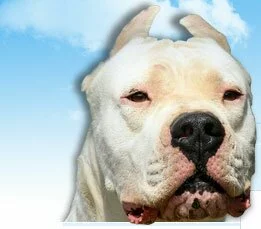 |
 |
|||
|
- - - - - - - - - - - - - - - - -- - - - - - - - - - - - - - - - - - - - - - - - - (Jadranko Terzic) The material that follows describes the jaws/teeth of Dogo Argentino; the way how it is required by the official standard (FCI Standard No. 292 / 29.01.1999.) and its evolution. The text is concluded by the standpoint of the majority of the Argentine breeders and judges of today in regards to this subject matter. It also includes what can be expected in the future based on the described items. The article includes a few drawings from the book “Todo Acereca del Dogo Argentino“ written by one of the most reputable breed experts, late Dr. Victor Valino - a friend, a great man who devoted the best years of his life in the process of development and recognition of Dogo Argentino as well as in educating many generations of dogueros.
And the text ...
For Dogo Argentino, as a specific hunting breed which catches its prey and locks on with terminal grip until the hunter arrives to finish it off, jaws and teeth are exceptionally important. “Jaws strong and well adapted; no under-or overshot mouth. The jaws should be slightly and homogeneously convergent. They ensure maximum bite capacity. Teeth big, well developed, firmly implanted in line, looking clean without caries. A complete dentition is recommended, priority being given to the homogeneous dental arches. Pincer bite, though scissors bite is accepted.”. The same standard states: Serious faults: Small, weak or decayed teeth. Incomplete dentition. Disqualifying faults: Over-or undershot mouth. - (Comment: Due to its function, preference is given to the pincer but majority of the breeders prefer scissors bite because of the simple reason:
Unfortunately, during the years that followed, due to the increased popularity of Dogo Argentino, different standpoints emerged in regards to the completeness of the dental arches. The interpretations of the standard were going into extremes such as that the multiple lack of molars was to be allowed as long as the missing teeth were not the ones to be adjacent or, that a big gap (as a result of missing two or more teeth in a row) was to be allowed justifying the interpretation that the gap is desired to ease breathing while pressing the prey (?!). It is apparent that the standard had to evolute in order to set more strict and more precise requirements in regards to the dentition. Today, the standpoint of the majority of the breeders from the country of origin is: At the end of this “short” review, it is reasonable to expect that the standard is to evolute in the future, and that the new version is to get more strict in regards to the completeness of the dental archess; the condition for complete jaws has been aleredy implemented by the majority of the breeders and judges in Argentina. |
||||
|
|
